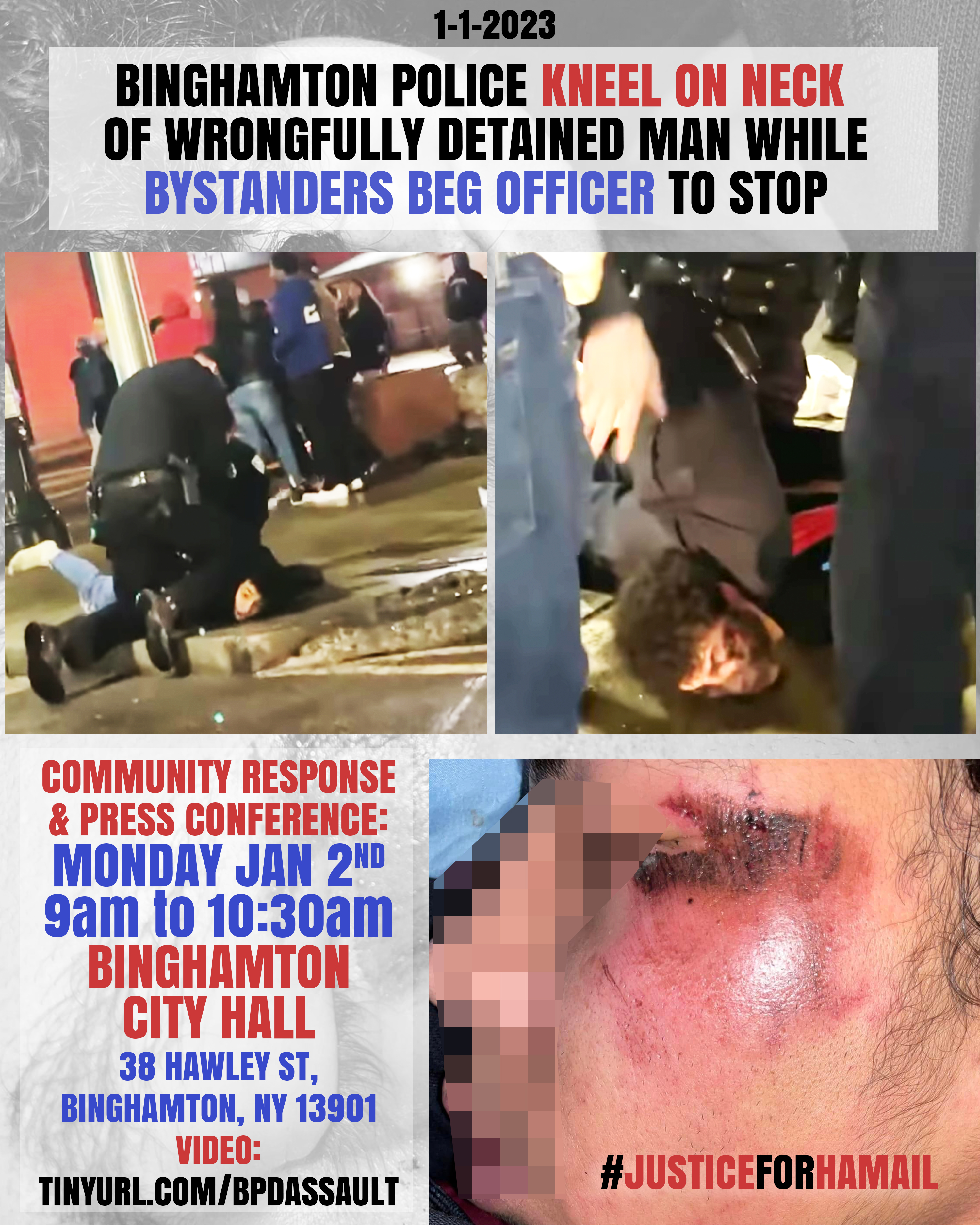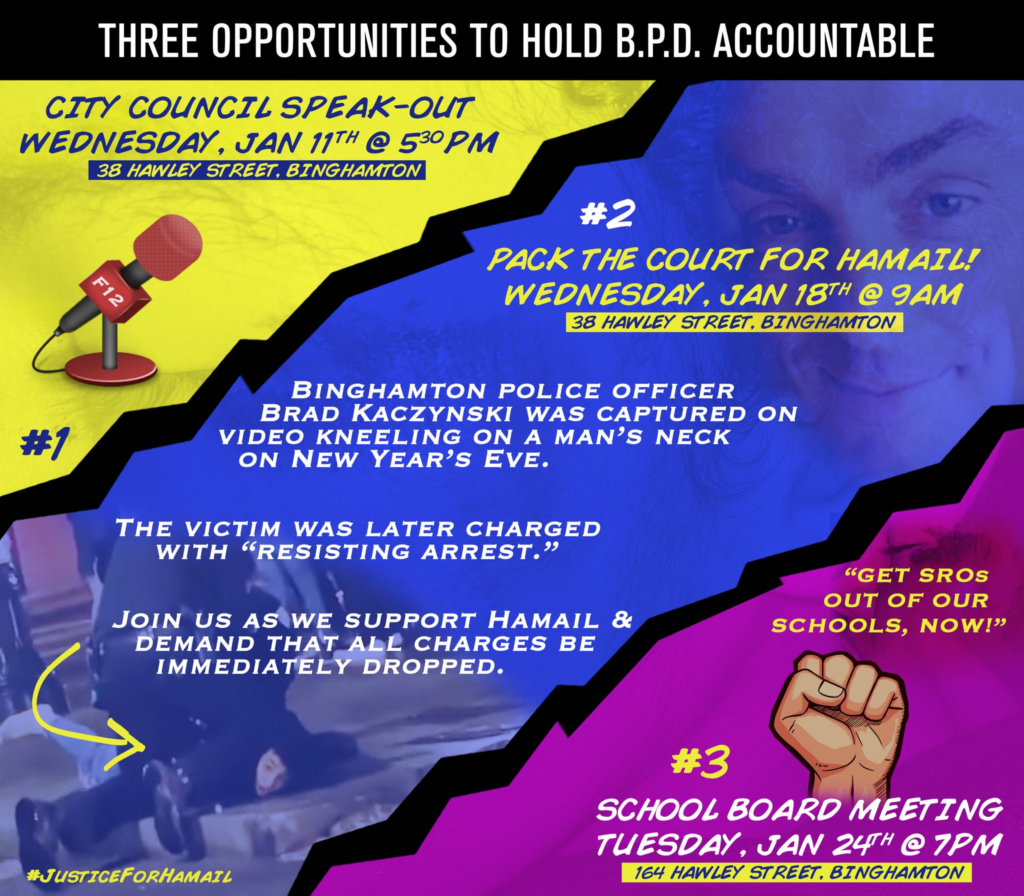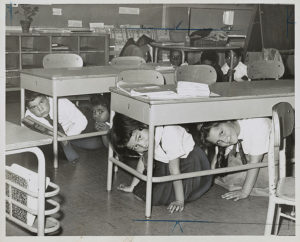
Recent and continuing community protests in the aftermath of a school police officer knelling on the neck of a young Black man brings to light yet once again the dangers and costs of placing officers in local schools (see video here, fuller story here, and local news reports here and here and protest here at a school board meeting). Immediately below is a reprint from May 2019 that details the history, costs, and research findings on “School Resource Officers”. In this case the cost of the school police officer involved? $99,000 in 2022 (before overtime and benefits), twice the average cost of a Binghamton school teacher.

And here are some questions one might ask about police in schools, including the alliance between the Binghamton Police Department and the SUNY-Binghamton Police Department.
Broome’s Schools & the Cost of Fear, May 4, 2019
How can we best educate Broome county’s kids and protect them from harm? The choices are tough for parents, teachers, and school principals. Do we spend
thin funding on more teachers or nurses? Or a guidance or a mental health counselor? Or when it comes to safety, hardening the schools against armed attack and hiring armed police? Unfortunately fear, and not a rational calculation of where dangers lie, drives today’s calculations.

Fear is a powerful motivator. In the Cold War years, children were drilled to “duck and cover” under their classroom desks to avoid the effects of Soviet atomic bombs. Today students and teachers practice turning off lights, locking classroom doors, pulling down window shades, and huddling quietly in closets to hide from active shooters. Surprise lockdown drills have become the norm, reproducing a climate of insecurity and anxiety. One in three parents nationwide fear for the safety of their child at school, fed by lurid media coverage and politically calculated calls for more state security.
Living in fear imposes costs and choices. Most prominent is the cost of police in our schools. In Broome County, as across the nation, the number of armed School Resource Officers (SROs) and civilian security staff has grown steadily. What does this cost? And has this reduced, prevented, or increased harm to our youth?
There is neither transparency nor much discussion here. School, city, and police budgets provide little help. Incomplete responses to freedom of information requests to local towns, police departments, and the county, in addition to a survey of press and website listings, produce an incomplete total for Broome County schools of $1.3 million per year. It looks like this:
| District | School Resource Officers | Non-sworn civilian monitors |
| Binghamton | $190,000 | $170,000 |
| Vestal | $108,000 | ? |
| Chenango, Maine-Endwell (Broome County Sheriff) | $108,000 | — |
| BOCES, Catholic Schools, Harpursville, Susquehanna Valley, Windsor; (District Attorney Cornwell’s Program) | $664,000 | ? |
| Johnson City | 0 | ? |
These are very incomplete figures, given that SRO costs remain hidden in many budgets, and even these tabulations do not include in most cases civilian security staff, costs of “hardening” school facilities, staff training, consultant fees, drill practices, etc.
For many of our elected representatives this is not nearly enough. State legislators, led by our Senator (and former Undersheriff and current police officer) Frederick Akshar, have long advocated putting armed officers in schools. Senate Bill S1330 cosponsored by Akshar proposes that the state directly fund a force of retired police officers in all public and private schools outside of New York City—while raising school security officer (SRO) pay over 60 per cent.
The cost? Close to $200 million a year.

As an employment program, adding 4,000 part-time retirees to the state payroll is impressive. Nationwide, we’ve seen billions now spent on policing and hardening schools. Yet glaringly absent are other resources: 14 million students go to a school with a police officer but no counselor, nurse, psychologist or social worker.
Even more critical is the simple fact that adding armed police to school hallways does little to protect youth from the dangers they may face. As multiple reports by security firms,[1] research scholars,[2] and the Congressional Research Service[3] tell us, deaths in schools from active shooters are a minuscule subset of school fatalities, less than 5 percent,[4] and an even smaller percentage of youth homicides or suicides by firearms.[5] Shootings in and around schools are also exceedingly rare. Students know this: their fear of attack or harm while in school has been falling for over two decades.[6] Students in schools do face harm but from sources armed police can do little to prevent or resolve: transport accidents, suicide, bullying, and hate crimes among other causes.
Indeed armed police may exacerbate these problems. They certainly increase the danger of kids ending up in what is commonly called the school-to-prison pipeline. For what we do know is that more policing in our schools is associated with more detention and arrests, particularly of African-American and Latinx students. Incidents previously addressed by teachers, principals, and parents are increasingly turned over to retired police officers, who by training rely upon force and the criminal justice system. Recent protests against Binghamton High School security staff beating down a Black student on Court street, and the strip searching of four young Black girls at East Middle School highlight the problem and the fear some students have of the police and security staff.
Indeed, as local statistics and national surveys indicate, policing in schools reinforces racial disparities, with racially dipropionate rates of detention and arrest feeding directly into the prison pipeline. African-Americans, for example, compose 10 percent of Broome County’s students, but account for 43% of juvenile detentions and 50% of those on probation supervision. Where are the precursors? In the Binghamton School District, which spends the most on armed and private security, African-American students are suspended at 2.5 times the rate for white students and suffer a 26% drop out rate. County-wide, African-American are 10 percent of youth but 43% of juvenile detentions and 50% of those on probation supervision.
It is simply too costly a system: too many police in schools, too many poor, disabled and students of color channeled into the criminal justice system, and too few counselors, nurses, and mental health workers in our schools to really help kids resolve the conflicts and troubles of growing up in these difficult times.
Twenty years ago DARE, the police program in schools to prevent drug use, was shown to be a total failure and it collapsed. We should do the same to its successors, and end, finally, unaccountable mass policing in our schools.
References
[1] Stephen C. Satterly Jr., “Report of Relative Risks of Death in U.S. K-‐12 Schools” (Safe Havens International, August 1, 2014).
[2] James H. Price and Jagdish Khubchandani, “School Firearm Violence Prevention Practices and Policies: Functional or Folly?,” Violence and Gender, March 19, 2019, https://doi.org/10.1089/vio.2018.0044.
[3] Authors Redacted, “School Resource Officers: Issues for Congress” (Congressional Research Service, July 5, 2018).
[4] Authors Redacted, 18.
[5] Price and Khubchandani, “School Firearm Violence Prevention Practices and Policies,” 2.
[6] Lauren Musu-Gillette et al., “Indicators of SChool Crime and Safety 2017” (Washington, D.C: U.S. Department of Education, U.S. Department of Justice. Office of Justice Programs. Bureau of Justice Statistics, March 2018), 105.
Recent Comments